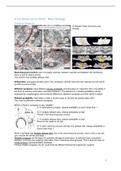College aantekeningen
Neurosciences year 1 - From Molecule to Mind (AM_1275) - summary lectures Neurobiology part
Summary of lecture notes of the course From Molecule to Mind (AM_1275), the part on Neurobiology, from the master Neuroscience at VU Amsterdam.
[Meer zien]






